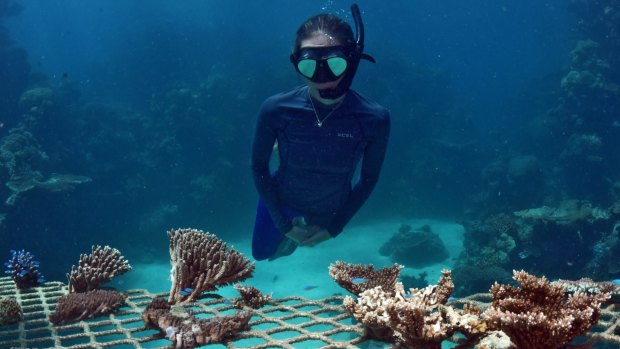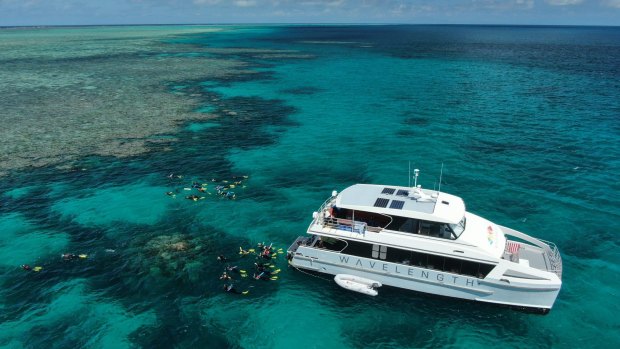This was published 1 year ago
Coral recovery at the Great Barrier Reef: Tour operators doing their bit
By Isobel King

Coral propagation involves planting broken fragments of living coral directly onto the reef.Credit: Tourism and Events Queensland
It's a mercifully beautiful autumn day out on the water, the ocean still, the sky piercing blue … and we've scored a prime seat smack beside the bench of delicious home-baked goodies the crew have laid out. Last week, apparently, conditions were wet, rough and windy. It's an auspicious start to a much-anticipated snorkelling trip to the outer Great Barrier Reef, 90 minutes by boat from Port Douglas.
I've even managed to score some exact prescription goggles, literally plucked at random out of a bucket.
My only reservation, despite the glowing tour operator reviews on TripAdvisor (5 stars from 3000+ reviews), are years of bleak reports about the state of the reef. Multiple bleachings, including devastating back-to-back events in 2016 and 2017 have taken their toll.

Wavelength Reef Cruises at Opal Reef.Credit: Tourism and Events Queensland
I've chosen this tour operator because it's owned and run by marine biologists, most of the crew are similarly trained, and they have exclusive moorings out at Opal Reef, where we're headed today. That means we've virtually guaranteed to have the place to ourselves. There'll be three different sites, chosen at the discretion of the skipper, with an hour's snorkelling at each.
As the boat pulls up to the first site mid-morning, the water is a tantalising Windex blue and I eagerly launch myself in. Immediately I'm engulfed by fish and the visibility is so clear that I can easily make out the coral gardens and shallow reefs I'm headed for.
There's no grey, cement-like coral graveyards here, just an explosion of marine life darting and weaving around the shallow reefs, which are definitely not a kaleidoscope of colours, but colourful they are, with punches of brilliant blue, dusty pinks and purples. Mostly I'm struck by how healthy and alive everything looks in this disrupted ecosystem. There are so many fish, big ones cruising solo, others in dense packs, and they all seem oblivious to the intruders in flippers. I even spot Nemo.
Each of the three sites is unique, chosen for the diversity of coral and fish. At the last, on a guided snorkel, I peer down to the white sand bed far below, and see sharks and turtles swimming among schools of fish. And I learn a lot about the lengths local operators are going to, to save their precious patch of reef.
Wavelength Reef Cruises is owned by Port Douglas locals, Jenny and John Edmondson, who took over the operation eight years ago. Imagine their horror when the bleachings of 2016 and 2017 virtually devastated the reef on their first watch. As marine biologists, they felt compelled to take action, teaming up with coral reef researchers at University of Technology Sydney to kickstart a coral propagation project. It involves planting broken fragments of living coral directly onto the reef, using a metal clip developed and patented by John.
Another aspect of the Coral Nurture Program is the coral nurseries, literally aluminium frames used to propagate coral. We see several of these out at Opal Reef and also at Fitzroy Island, off Cairns, where we stayed earlier in the holiday and had some great snorkelling straight off the beach.
It's clear that local operators are desperately trying to combat both the devastating effects of ocean warming and the negative media coverage it attracts. And they need our support.
"If people go to the Great Barrier Reef they want to see pretty coral and fish, and go, 'Yeah that's amazing'," says Jenny Edmondson. "On our sites, there's quite high coral cover naturally anyway, and [with our propagation] we increase that by maybe 10 per cent-plus in some areas, and in others, by 40 to 50 per cent."
In total, there are now six reef operators who are part of the program, propagating coral in their patch of reef. While the success of the program is obvious, operators like the Edmondsons are realistic that all their efforts do is buy time and stave off the immediate impacts of bleaching in very confined areas of the Great Barrier Reef – the largest living structure on earth.
"Coral reefs everywhere are definitely under threat," says Jenny. "If you think oceans are 20 years behind the land [in terms of ecological impact] then it's a massive emergency to do something."
THE DETAILS
TOUR
Wavelength Reef Cruises runs full-day tours to the outer Great Barrier Reef from Port Douglas, carrying a maximum of 48 passengers. Prices: Adult $250; Child $190 (6-14 years); Family $850 (2 adults and 2 children) See wavelength.com.au
MORE
Isobel King travelled at her own expense.
Sign up for the Traveller Deals newsletter
Get exclusive travel deals delivered straight to your inbox. Sign up now.